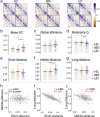Functional brain rewiring and altered cortical stability in ulcerative colitis
- PMID: 35046525
- PMCID: PMC9095465
- DOI: 10.1038/s41380-021-01421-6
Functional brain rewiring and altered cortical stability in ulcerative colitis
Abstract
Despite recent advances, there is still a major need to better understand the interactions between brain function and chronic gut inflammation and its clinical implications. Alterations in executive function have previously been identified in several chronic inflammatory conditions, including inflammatory bowel diseases. Inflammation-associated brain alterations can be captured by connectome analysis. Here, we used the resting-state fMRI data from 222 participants comprising three groups (ulcerative colitis (UC), irritable bowel syndrome (IBS), and healthy controls (HC), N = 74 each) to investigate the alterations in functional brain wiring and cortical stability in UC compared to the two control groups and identify possible correlations of these alterations with clinical parameters. Globally, UC participants showed increased functional connectivity and decreased modularity compared to IBS and HC groups. Regionally, UC showed decreased eigenvector centrality in the executive control network (UC < IBS < HC) and increased eigenvector centrality in the visual network (UC > IBS > HC). UC also showed increased connectivity in dorsal attention, somatomotor network, and visual networks, and these enhanced subnetwork connectivities were able to distinguish UC participants from HCs and IBS with high accuracy. Dynamic functional connectome analysis revealed that UC showed enhanced cortical stability in the medial prefrontal cortex (mPFC), which correlated with severe depression and anxiety-related measures. None of the observed brain changes were correlated with disease duration. Together, these findings are consistent with compromised functioning of networks involved in executive function and sensory integration in UC.
© 2021. The Author(s).
Conflict of interest statement
EAM is a scientific advisory board member of Danone, Axial Biotherapeutics, Viome, Amare, Mahana Therapeutics, Pendulum, Bloom Biosciences, APC Microbiome Ireland. CNB is on the advisory boards for Abbvie Canada, Amgen Canada, Bristol Myers Squibb Canada, Janssen Canada, Roche Canada, Sandoz Canada, Takeda Canada, and Pfizer Canada. CNB is also a consultant for Mylan Pharmaceuticals. CNB has received educational grants from Abbvie Canada, Janssen Canada, Takeda Canada, and Pfizer Canada. CNB has received research funding from Abbvie Canada. CNB is on the speaker’s bureau for Abbvie Canada, Janssen Canada, Takeda Canada, and Medtronic Canada. No other authors have anything to disclose.
Figures








